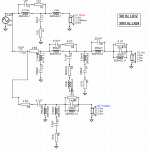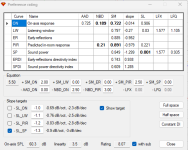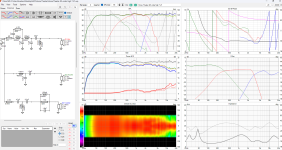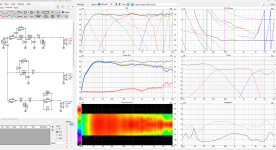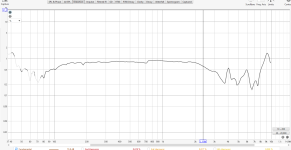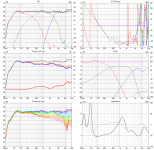I noticed that the midrange filter network includes a small electrical resonance at about 5.2kHz. The tweeter filter network also has a similar electrical resonance, at about 2.0kHz. Would it be possible to adjust the filter networks in question to remove those two resonances?
The y offset on the mid should be zero (see earlier discussions regarding tweeter and mid both measured at the midpoint between them)A bit less simpler: xo freq @ 300 LR2 and 3500Hz LR4 to protect the tw. There's a bit too much energy at 2kHz, but it seems a good compromise.
I feel like I'm going in circles now. It also seems like everyone is lining up very similar in how they are getting the responses and the XO where we all think it should be. I have two options. On the left is a 2800 & 320 hz XO. On the right we have a 3500 & 280 XO.
Looking at the distortion figures also attached which would you consider better?
Looking at the distortion figures also attached which would you consider better?
Attachments
Last edited:
Attached without those two notches: on axis is more linear , but the PR blooms at the sensitive 2K to 5K region....I noticed that the midrange filter network includes a small electrical resonance at about 5.2kHz. The tweeter filter network also has a similar electrical resonance, at about 2.0kHz. Would it be possible to adjust the filter networks in question to remove those two resonances?
Edit: @witwald sorry I thought you were referring to my post #101
Attachments
Last edited:
Reading this I was like "how can you afford to build multiples?" until you said you had a cache of components. I did spec out a crossover and it came out to $200. Divided by the amount of enjoyment this will bring to my life it is an insignificant number. It is, though, not exactly cheap.
You can probably decide pretty conclusively on the woofer low pass and midrange high pass based on the simulation you settle on.
As you listen to them you may want to tweak the mid low pass and tweeter high pass, as small changes are going to affect the 1khz to 5khz range where our ears are most sensitive. You could (1) stock up on some different values of Dayton or Audyn Q4 caps (this makes sense if you are going to design more speakers or you could turn around and sell what you don't use in the Swap Meet section) or (2) load up on cheap NPE caps for testing and when you get to a final decision order some better quality caps in the values you need. Unfortunately there is not cheap alternative similar to NPE caps for inductors.
Yes - look at my crossover in post #48 - midrange cone resonances at about 5 kHz and 10 kHz are -35 dB below the signal. Tweeter resonance at 2 kHz can be killed also, but only with more complex filter.I noticed that the midrange filter network includes a small electrical resonance at about 5.2kHz. The tweeter filter network also has a similar electrical resonance, at about 2.0kHz. Would it be possible to adjust the filter networks in question to remove those two resonances?
...On the right we have a 2500 & 280 XO.
Did you mean 3500 (asking because that is what it looks like in the screenshot)
Done. Differences are negligible. Vertical directivity is slightly better at mid-tw xo freqeuncy, but PR is a bit worse at 2kHz.The y offset on the mid should be zero (see earlier discussions regarding tweeter and mid both measured at the midpoint between them)
It blooms there because the previous design (see Post #101) had a mild case of "BBC dip"-itis in the 2–5kHz region. I think it's more important to get the on-axis response flatter and remove undesirable resonances sitting not all that far below the summed response, which can be easily excited by music program material. That choice is made on the basis that the direct sound from the loudspeaker will, in most listening situations, most strongly influence the listener's perception of the sound reproduction quality.Attached without those two notches: on axis is more linear , but the PR blooms at the sensitive 2K to 5K region....
Witwald,
I am unsure what you you mean by "remove undesirable resonances sitting not all that far below the summed response". Can you please elaborate.
I am unsure what you you mean by "remove undesirable resonances sitting not all that far below the summed response". Can you please elaborate.
The plots below, taken from Post #101, indicate the presence of resonances in the midrange (blue square) and tweeter (red circle) responses that have been created by their respective filter networks. The peaks in the relevant Filter responses curve indicate that undesirable resonances are being introduced. The one in the tweeter's high-pass rolloff, located at 2.0kHz, is only 15dB below the summed response. I would hazard a guess that that is undesirable. The one on the filter for the midrange is located at about 5kHz, and it is a relatively high-Q resonance that is only 17dB below the level of the summed response. I would be concerned that these resonances might be audible.

Last edited:
CTA2034 seems intended as a generalised metric for existing products first. The listening window may be an overrated property there to cover different situations. If anything, the listening window outside the listening position may have little effect, less than the early reflections in any case because they may proceed directly to the reverberant field.Yeah. To expand, I think it would be even better not to think just one listening axis but have mindset to make whole listening window good instead.
Yeah thats true, I thought to write about this because I've found toe-in important tool to adjust sound in room for sweet spot(s) so freedom to do that without worrying about llistening axis feels very valuable to me. Long story short I've got two sweetspots, closer to speakers for good involving sound and further out for more relaxing sound, the classic "you are there" and "they are here" are available both at will just by changing listening distance a bit. Changing listening distamce changes listening axis but also all early reflection axis.
In addition I've learned to value sound that doesn't change much moving laterally either, it makes a calm feeling hanging out in the room, as the sound (timbre) doesn't change much at all focus stays on the music and is hardly ever drawn to the sound itself. As these are subjective stuff and small sample size me fooling around in my house, perhaps it's not applicable/valuable for many others. Also, it's not crossover that makes this, although part of, but the whole physical construct of the speaker.
In addition I've learned to value sound that doesn't change much moving laterally either, it makes a calm feeling hanging out in the room, as the sound (timbre) doesn't change much at all focus stays on the music and is hardly ever drawn to the sound itself. As these are subjective stuff and small sample size me fooling around in my house, perhaps it's not applicable/valuable for many others. Also, it's not crossover that makes this, although part of, but the whole physical construct of the speaker.
It just goes to show it's not appropriate for designers to use a method that has a fixed listening angle. Does 0 degrees really have a meaning to the speaker?.. or does it just look good to our sensibilities..I thought to write about this because I've found toe-in important tool to adjust sound in room for sweet spot(s) so freedom to do that without worrying about llistening axis feels very valuable to me.
Yeah if there is intent to optimally position listening triangle it might be hard to know beforehand what the listening axis eventually ends up, so it's just more flexible setup to have many/wide good listening axis.It just goes to show it's not appropriate for designers to use a method that has a fixed listening angle. Does 0 degrees really have a meaning to the speaker?.. or does it just look good to our sensibilities..
~0-axis is special for top octave which usually has quite high DI, but there might be issues as well, like cone breakup beaming distortion products, which might be audible. Also any diffraction issues get highlighted, but these can also be designed away, at least addressed some. In general it's quite easy to notice where the 0-axis is. I don't have enough experience yet to get any deeper than this whether it's good or bad in any particular situation.
Many people do not seem to play with toe-in that much, lots of photos of setups with no toe-in for example, perhaps due to listening quite far away so that early reflections dominate perception anyway and listening directly on axis makes the highs stick out as "dry" in-your face compared to rest of the range and thus it's better to point speakers somewhere else than dorectly to listening spot. This has now optimized the far listening distance for nice balanced sound, but as side effect might prevent people to notice there is another sound available with shorter listening distance. I think tuning sound for the close listening distance benefits more from freedom for toe-in than listening further away for two reasons: brain pays much more attention to direct sound so any problrms are more apparent, and also some adjustability for envelopment. Ideally one should, or could, optimize for both. Some records sound better on either listening distance, or both, but also mood affects which is more fun.
- Home
- Loudspeakers
- Multi-Way
- 3 way XO help

